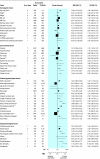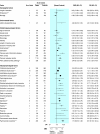Factors predisposing women to chronic pelvic pain: systematic review
- PMID: 16484239
- PMCID: PMC1420707
- DOI: 10.1136/bmj.38748.697465.55
Factors predisposing women to chronic pelvic pain: systematic review
Abstract
Objective: To evaluate factors predisposing women to chronic and recurrent pelvic pain. DESIGN, DATA SOURCES, AND METHODS: Systematic review of relevant studies without language restrictions identified through Medline, Embase, PsycINFO, Cochrane Library. SCISEARCH, conference papers, and bibliographies of retrieved primary and review articles. Two reviewers independently extracted data on study characteristics, quality, and results. Exposure to risk factors was compared between women with and without pelvic pain. Results were pooled within subgroups defined by type of pain and risk factors.
Results: There were 122 studies (in 111 articles) of which 63 (in 64,286 women) evaluated 54 risk factors for dysmenorrhoea, 19 (in 18,601 women) evaluated 14 risk factors for dyspareunia, and 40 (in 12,040 women) evaluated 48 factors for non-cyclical pelvic pain. Age < 30 years, low body mass index, smoking, earlier menarche (< 12 years), longer cycles, heavy menstrual flow, nulliparity, premenstrual syndrome, sterilisation, clinically suspected pelvic inflammatory disease, sexual abuse, and psychological symptoms were associated with dysmenorrhoea. Younger age at first childbirth, exercise, and oral contraceptives were negatively associated with dysmenorrhoea. Menopause, pelvic inflammatory disease, sexual abuse, anxiety, and depression were associated with dyspareunia. Drug or alcohol abuse, miscarriage, heavy menstrual flow, pelvic inflammatory disease, previous caesarean section, pelvic pathology, abuse, and psychological comorbidity were associated with an increased risk of non-cyclical pelvic pain.
Conclusion: Several gynaecological and psychosocial factors are strongly associated with chronic pelvic pain. Randomised controlled trials of interventions targeting these potentially modifiable factors are needed to assess their clinical relevance in chronic pelvic pain.
Figures





References
-
- Zondervan KT, Yudkin PL, Vessey MP, Dawes MG, Barlow DH, Kennedy SH. Prevalence and incidence of chronic pelvic pain in primary care: evidence from a national general practice database. Br J Obstet Gynaecol 1999;106: 1149-55. - PubMed
-
- Howard FM. The role of laparoscopy in chronic pelvic pain: promise and pitfalls. Obstet Gynecol Surv 1993;48: 357-87. - PubMed
-
- Davies L, Ganger K, Drummond M, Saunders D, Beard R. The economic burden of intractable gynaecological pain. J Obstet Gynaecol 1992;12: 46-54.
-
- Mathias SD, Kuppermann M, Liberman RF, Lipschutz RC, Steege JF. Chronic pelvic pain: prevalence, health-related quality of life, and economic correlates. Obstet Gynecol 1996;87: 321-7. - PubMed
-
- Howard FM. The role of laparoscopy in chronic pelvic pain: promise and pitfalls. Obstet Gynecol Surv 1993;48: 357-87. - PubMed
Publication types
MeSH terms
LinkOut - more resources
Full Text Sources
Other Literature Sources
Medical
